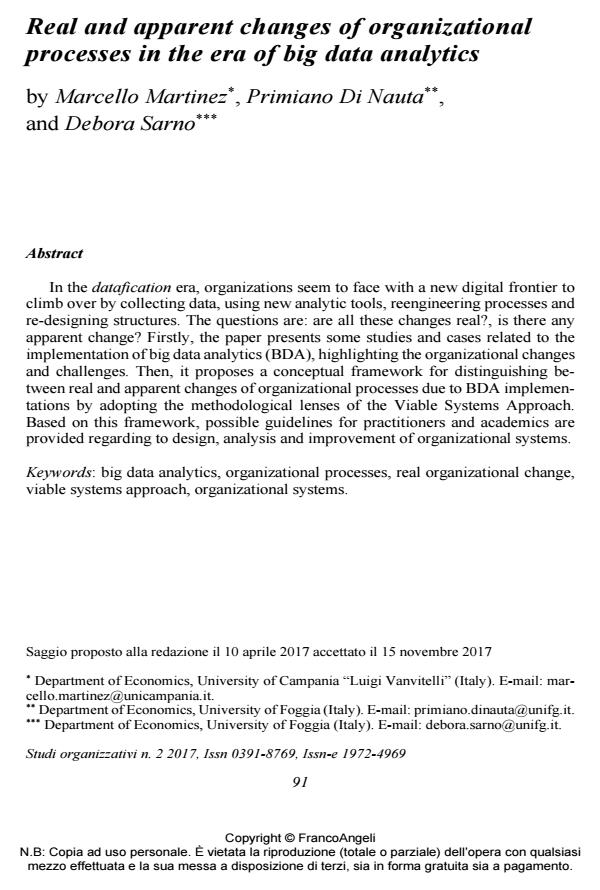Real and apparent changes of organizational processes in the era of big data analytics
Journal title STUDI ORGANIZZATIVI
Author/s Marcello Martinez, Primiano Di Nauta, Debora Sarno
Publishing Year 2018 Issue 2017/2
Language English Pages 17 P. 91-107 File size 226 KB
DOI 10.3280/SO2017-002005
DOI is like a bar code for intellectual property: to have more infomation
click here
Below, you can see the article first page
If you want to buy this article in PDF format, you can do it, following the instructions to buy download credits

FrancoAngeli is member of Publishers International Linking Association, Inc (PILA), a not-for-profit association which run the CrossRef service enabling links to and from online scholarly content.
In the datafication era, organizations seem to face with a new digital frontier to climb over by collecting data, using new analytic tools, reengineering processes and re-designing structures. The questions are: are all these changes real?, is there any apparent change? Firstly, the paper presents some studies and cases related to the implementation of big data analytics (BDA), highlighting the organizational changes and challenges. Then, it proposes a conceptual framework for distinguishing between real and apparent changes of organizational processes due to BDA implementations by adopting the methodological lenses of the Viable Systems Approach. Based on this framework, possible guidelines for practitioners and academics are provided regarding to design, analysis and improvement of organizational systems.
Keywords: Big data analytics, organizational processes, real organizational change, viable systems approach, organizational systems.
- Complexity and Sustainability in Megaprojects Primiano Di Nauta, Cristina Simone, Francesca Iandolo, Stefano Armenia, Marco Arcuri, pp.35 (ISBN:978-3-031-30878-9)
- Towards Digital and Sustainable Organisations Paolo Canonico, Ernesto De Nito, Vincenza Esposito, Marcello Martinez, Mario Pezzillo Iacono, pp.89 (ISBN:978-3-031-52879-8)
- Significance and Challenges of Data-driven Product Generation and Retrofit Planning Melina Massmann, Maurice Meyer, Roman Dumitrescu, Sebastian von Enzberg, Maximilian Frank, Christian Koldewey, Arno Kühn, Jannik Reinhold, in Procedia CIRP /2019 pp.992
DOI: 10.1016/j.procir.2019.04.226 - Smart Education and e-Learning - Smart Pedagogy Barbara Borin, Matteo Caroli, Nunzio Casalino, Maurizio Cavallari, Nadia Di Carluccio, Primiano Di Nauta, Giuliana Pizzolo, pp.211 (ISBN:978-981-19-3111-6)
- Smart Education and e-Learning 2021 Nunzio Casalino, Stefano Armenia, Primiano Di Nauta, pp.197 (ISBN:978-981-16-2833-7)
- Rethinking Work: Pathways and Practices in Business and Society. Introduction to the Special Issue. Luigi Moschera, Mario Pezzillo Iacono, Giovanna Lo Nigro, Laura Lucia Parolin, in STUDI ORGANIZZATIVI 2/2019 pp.9
DOI: 10.3280/SO2018-002001 - Smart Education and e-Learning - Smart Pedagogy Elisa Bertocchi, Matteo Caroli, Nunzio Casalino, Stefano Falà, Marco Giovannetti, Katia Infante, Alessia Orsi, Emanuela Mariotti, Fabio Massimi, Valerio Manzo, Giuliana Pizzolo, Giovanni Paolo Sellitto, pp.269 (ISBN:978-981-19-3111-6)
Marcello Martinez, Primiano Di Nauta, Debora Sarno, Real and apparent changes of organizational processes in the era of big data analytics in "STUDI ORGANIZZATIVI " 2/2017, pp 91-107, DOI: 10.3280/SO2017-002005